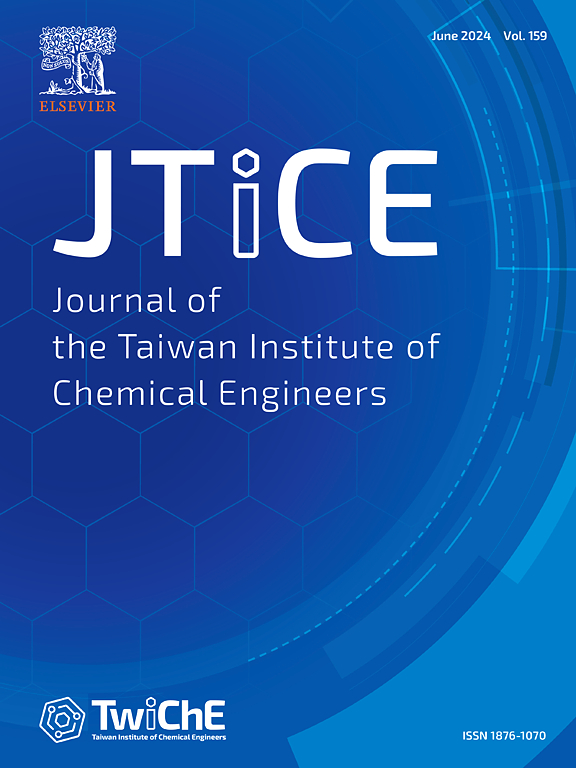Adsorption-degradation properties of magnetic porous biochar (FeXZn@BC) in the removal of TC and Cu2+
IF 5.5
3区 工程技术
Q1 ENGINEERING, CHEMICAL
Journal of the Taiwan Institute of Chemical Engineers
Pub Date : 2025-03-08
DOI:10.1016/j.jtice.2025.106063
引用次数: 0
Abstract
Background
Copper (Cu2+) and antibiotics are common and co-existing pollutants in wastewater from livestock and poultry farms.
Methods
Magnetic porous carbon (FeXZn@BC) with different iron contents was prepared by one-step using zinc chloride and ferric chloride as modifiers. Tetracycline (TC) and Cu2+ as target pollutants were used to investigate the adsorption properties of FeXZn@BC. Additionlly, the degradation performances of FeXZn@BC activating peroxymonosulfate (PMS) and iodide (IO4−) on TC degradation were further investigated.
Significant Findings
The order of the adsorption capacities of the adsorbents for TC was (mmol·g−1): Fe2Zn@BC (1.39) > Fe5Zn@BC (1.09) > Fe10Zn@BC (1.03) > BC (0.03), and for Cu2+ was (mmol·g−1): Fe2Zn@BC (1.93) > Zn@BC (1.39) > Fe5Zn@BC (1.29) > Fe10Zn@BC (1.00) > BC (0.28). The FeXZn@BC also could catalyze PMS for TC degradation, and the removal of TC by PMS could be strengthened in the presence of Cu2+. Dynamic experiments on the removal of TC in water using Fe2Zn@BC were conducted, and the effects of PMS and Cu2+ on the dynamic experiments of TC removal were investigated. This study provides a new perspective on the co-removal of antibiotics and heavy metals Cu2+.

磁性多孔生物炭(FeXZn@BC)去除TC和Cu2+的吸附降解性能
背景铜(Cu2+)和抗生素是畜禽养殖场废水中常见且共存的污染物。方法以氯化锌和氯化铁为改性剂,一步法制备不同铁含量的磁性多孔碳(FeXZn@BC)。以四环素(TC)和Cu2+为目标污染物,考察FeXZn@BC的吸附性能。此外,还进一步研究了FeXZn@BC活化过氧单硫酸盐(PMS)和碘化物(IO4−)对TC的降解性能。各吸附剂对TC的吸附量大小依次为(mmol·g−1):Fe2Zn@BC (1.39) >;Fe5Zn@BC (1.09) >;Fe10Zn@BC (1.03) >;Cu2+为(mmol·g−1):Fe2Zn@BC (1.93) >;Zn@BC (1.39) >;Fe5Zn@BC (1.29) >;Fe10Zn@BC (1.00) >;BC(0.28)。FeXZn@BC还能催化PMS降解TC,且在Cu2+存在下PMS对TC的去除能力增强。采用Fe2Zn@BC对水中TC进行了动态去除实验,考察了PMS和Cu2+对TC动态去除实验的影响。本研究为抗生素与重金属Cu2+的协同去除提供了新的视角。
本文章由计算机程序翻译,如有差异,请以英文原文为准。
求助全文
约1分钟内获得全文
求助全文
来源期刊
CiteScore
9.10
自引率
14.00%
发文量
362
审稿时长
35 days
期刊介绍:
Journal of the Taiwan Institute of Chemical Engineers (formerly known as Journal of the Chinese Institute of Chemical Engineers) publishes original works, from fundamental principles to practical applications, in the broad field of chemical engineering with special focus on three aspects: Chemical and Biomolecular Science and Technology, Energy and Environmental Science and Technology, and Materials Science and Technology. Authors should choose for their manuscript an appropriate aspect section and a few related classifications when submitting to the journal online.

 求助内容:
求助内容: 应助结果提醒方式:
应助结果提醒方式:


